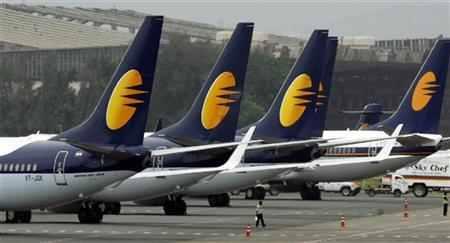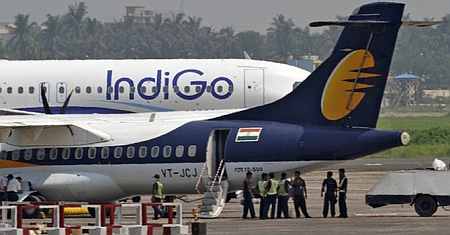 | « Back to article | Print this article |
How Jet Airways has managed to retain its top position
In the aviation sector, FY 2012 will be remembered for record losses, downsizing of Kingfisher, Air India's constant labour crisis, IndiGo's rapid rise -- and Jet Airways' continued dominance of Indian skies.
No wonder, the stock market just loves India's largest airline by market share. Shares of Jet have jumped almost 30 per cent in a month, outperforming other airlines.
Despite a tough operating environment and 42 per cent spike in fuel costs, Jet has managed to stay ahead of the curve adding capacity and seizing advantage of Kingfisher's downslide.
Click NEXT to read more...
How Jet Airways has managed to retain its top position
Data show that in the fourth quarter of 2012, Jet grew faster than domestic competition in both capacity as well as number of passengers.
While industry capacity grew 12 per cent, Jet plus Jetlite (rebranded as Jet Konnect in March) grew 22 per cent.In terms of passenger flown, Jet grew 23 per cent against the total industry passenger growth of 7 per cent. This was the second successive quarter of growth for Jet, after its growth was slower than the industry average in the first and second quarters.
What exactly did Jet do to achieve this? The airline added capacity both by adding new flights and reconfiguring its Boeing 737 planes, which are flown on the domestic and short-haul international routes. Jet along with Jet Konnect has a market share of 28.2 per cent.
Click NEXT to read more...
How Jet Airways has managed to retain its top position
In the third quarter, Jet added 30 daily flights in its winter schedule connecting Madurai, Bangalore, Chennai, Kolkata, Ahmedabad and other cities, and in the fourth quarter, it added eight daily flights in JetLite.
However, the main increase in capacity came through aircraft reconfiguration. While Air India is planning to reconfigure planes to reduce business class seats and Kingfisher too has carried out the same on its airbus fleet, Jet reconfigured 19 Boeing 737 planes during the last six months.
With this, Jet halved the business class seats in these planes to eight but increased the overall capacity by 16 seats per flight. Instead of 16 + 138 and 16 + 102 configuration, the airline flies 8+162 and 8+126 configuration.
Click NEXT to read more...
How Jet Airways has managed to retain its top position
"We decided on the strategy early last year before Kingfisher Airlines reduced its frequencies. There wasn't such a great demand for Premiere (business class) outside the metros.
We also wanted to increase revenue per flight and make our assets more productive. The strategy is paying off. We increased the market share and revenues with the same number of planes," says Jet's Chief Executive Officer Nikos Kardassis. Reconfiguration has resulted in higher revenue per flight and lower cost per seat, he adds.
On a consolidated basis, revenue grew 24 per cent to Rs 4,638 crore (Rs 46.38 billion) in Q4, 2012 and passenger carried increased 23 per cent. On a standalone basis, yields increased 9.6 per cent on a Y-o-Y basis.
Click NEXT to read more...
How Jet Airways has managed to retain its top position
Also, Jet has posted an operating profit compared with an operating loss in the December quarter. The company attributes the better operating performance to "increase in fares and strict cost control measures".
Another fallout of Kingfisher's reduced operations and flight disruptions in the earlier part of the year was transfer of business class passenger traffic to Jet Airways.
Travel agencies too stopped booking on Kingfisher as the airline faced cash crunch and was suspended from the International Air Transport Association's billing settlement plan.
Click NEXT to read more...
How Jet Airways has managed to retain its top position
As corporate clients moved away from Kingfisher, Jet saw 14 per cent growth in domestic business class passenger numbers in Q4 2012 on a Y-o-Y basis.
Centre for Asia Pacific Aviation's Kapil Kaul says Jet Airways has been and will continue to be the largest beneficiary of Kinghfisher's contraction from 66 to 16 operational aircraft.
Click NEXT to read more...
How Jet Airways has managed to retain its top position
Half of these regional ATR aircraft and has left the domestic business market open for Jet. CAPA expects Jet to place an order for 100 narrow body planes in FY 2013 and is evaluating Airbus A320neo.
But it's not roses all the way. The improvements in its numbers can't hide the fact that Jet's net profitability hasn't improved.
The company's March quarter loss at Rs 298 crore (Rs 2.98 billion) has widened by a huge margin year-on-year as well as sequentially because of higher interest and depreciation cost that have been eating into its earnings before interest, tax, depreciation and amortisation operating margin has also declined from 11.6 per cent to 9.2 per cent.
Click NEXT to read more...
How Jet Airways has managed to retain its top position
Also, according to travel industry sources, though Jet gained in the premium traffic and on metro routes, IndiGo grabbed a larger pie of passengers in Q4.
"Jet went in for revenue growth and IndiGo got the market share," an aviation industry source says, pointing out that because of lower fares, IndiGo increased its market share.
The Directorate General of Civil Aviation data show though Jet plus Jet Konnect have a higher market share and led the pack in May, IndiGo has 24.9 per cent market share which is higher than Jet (standalone) share at 21.4 per cent.
Till about six months back, IndiGo's market share was around 19-20 per cent. That's some food for thought for Jet Airways.








